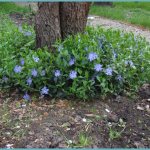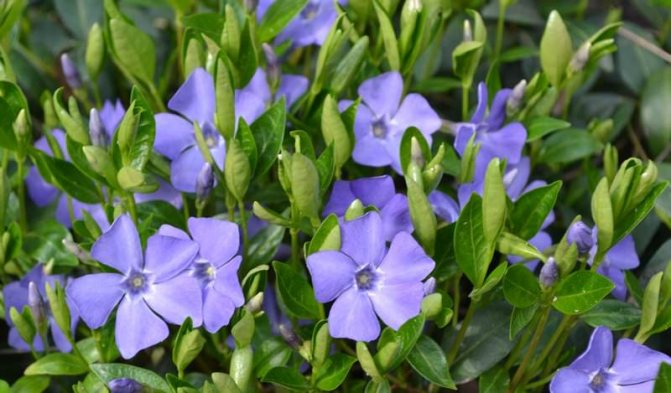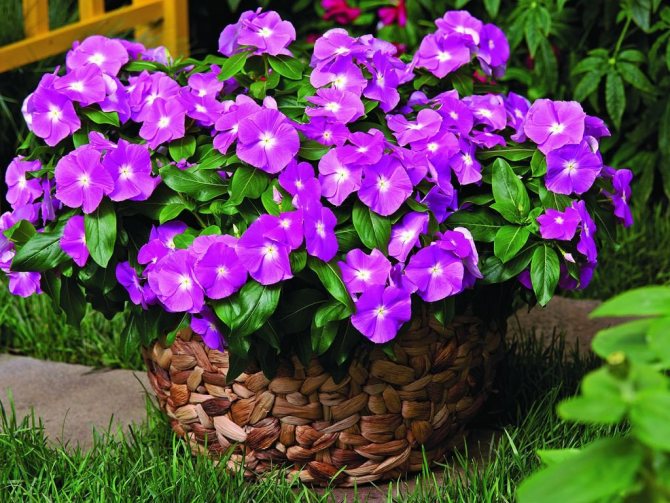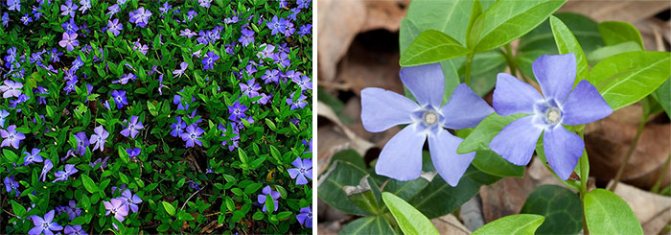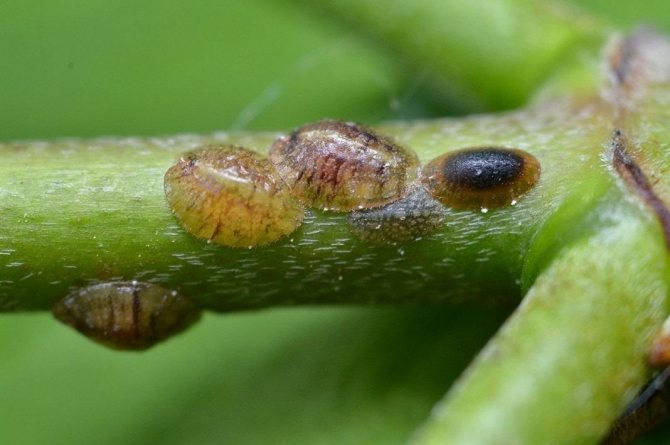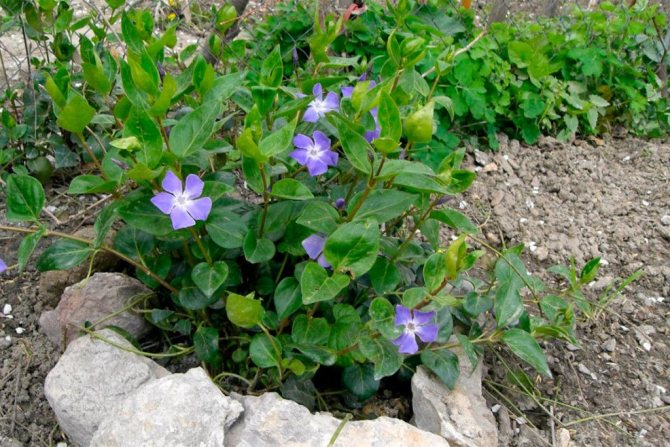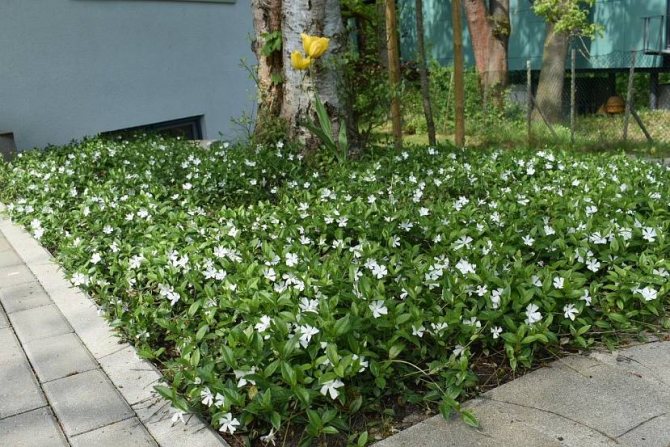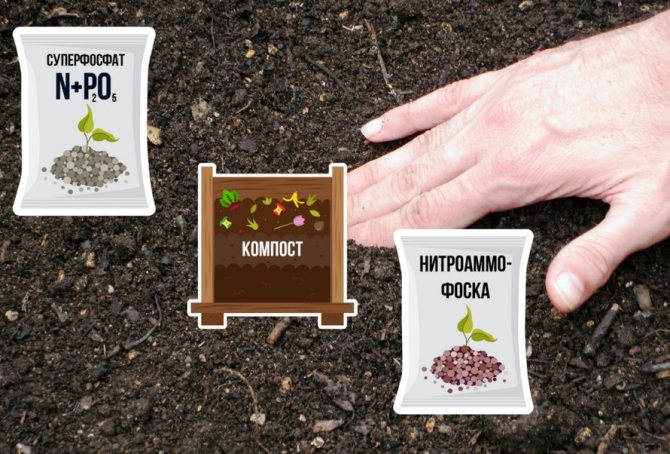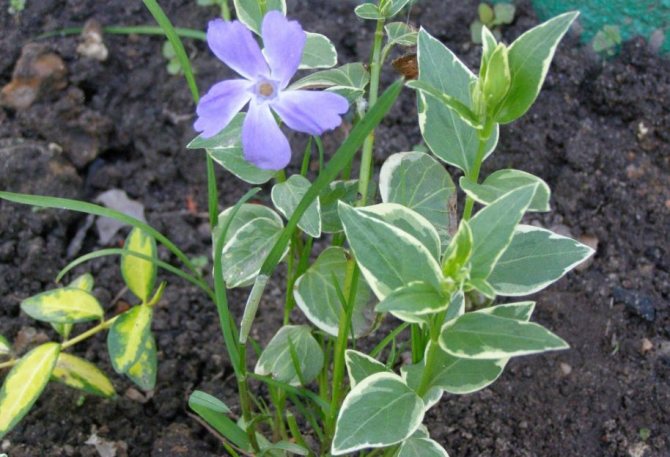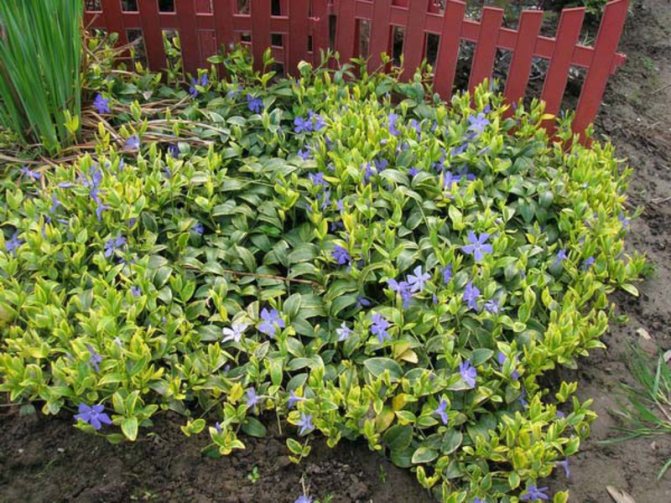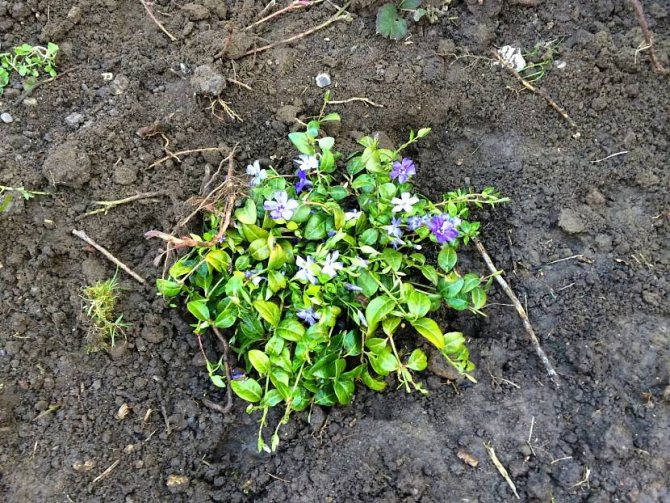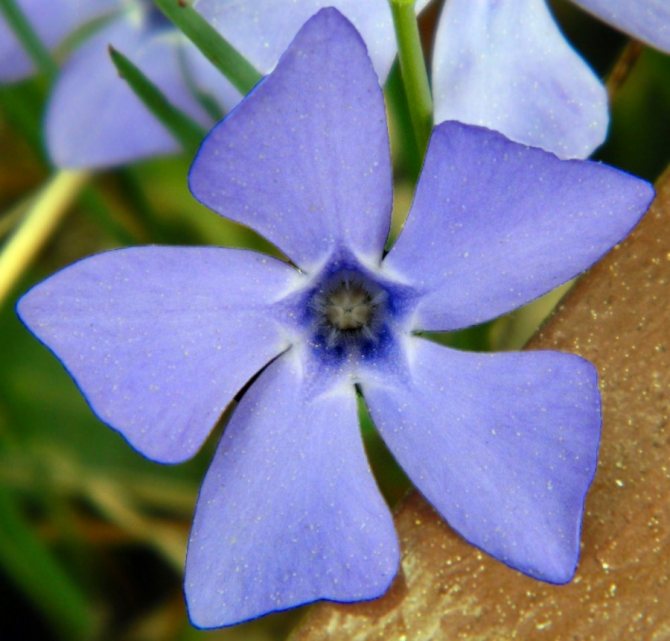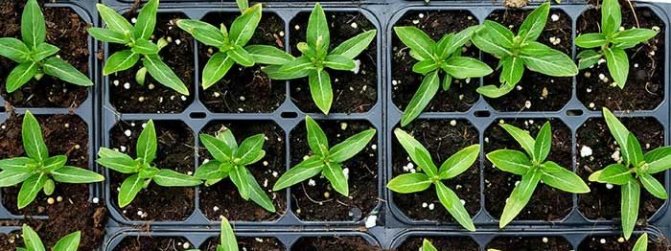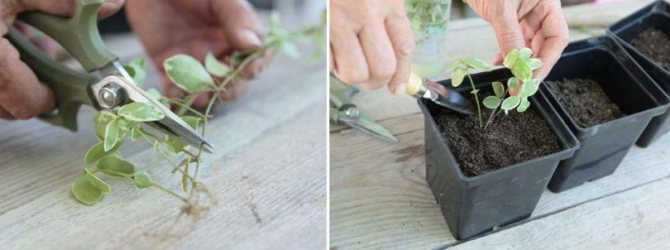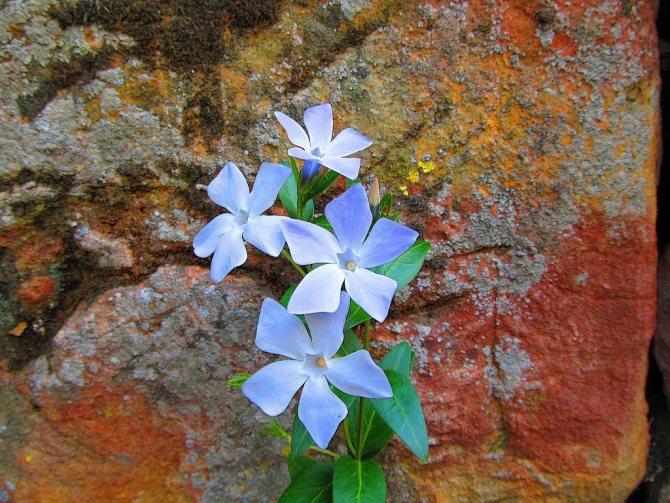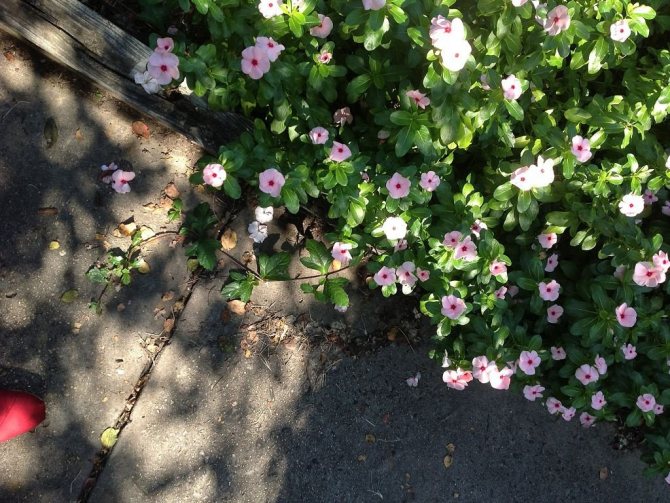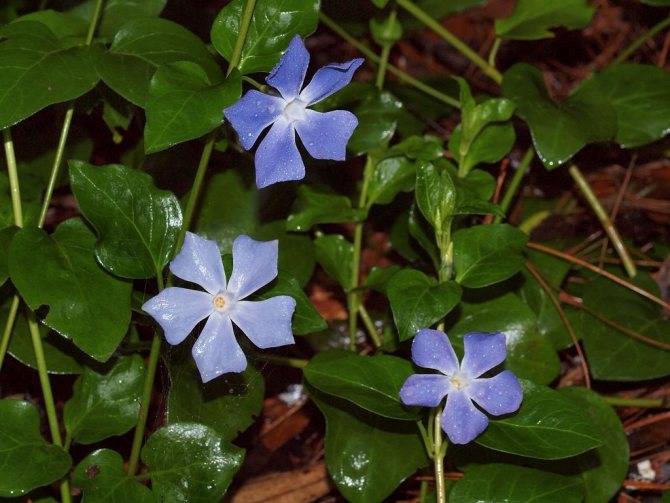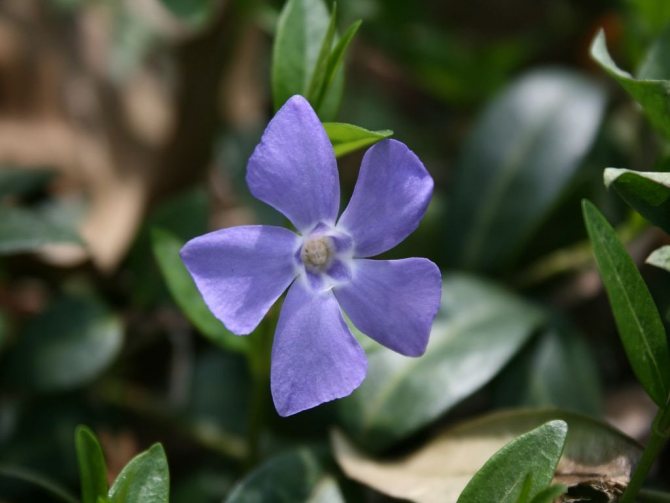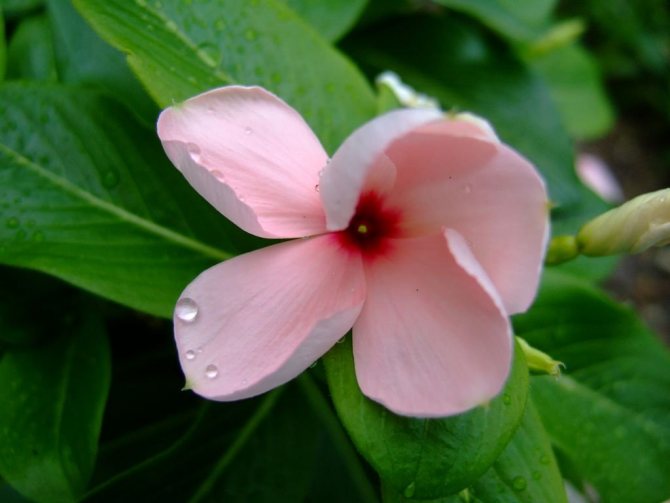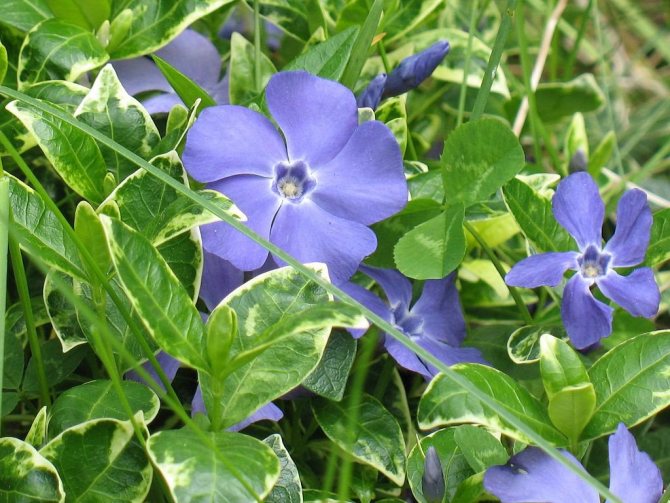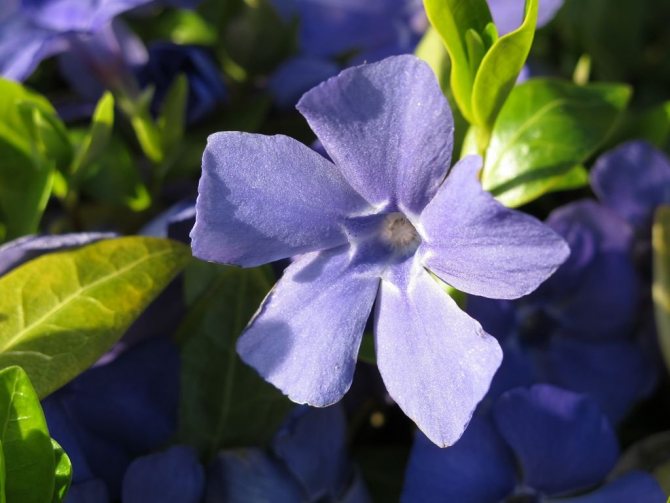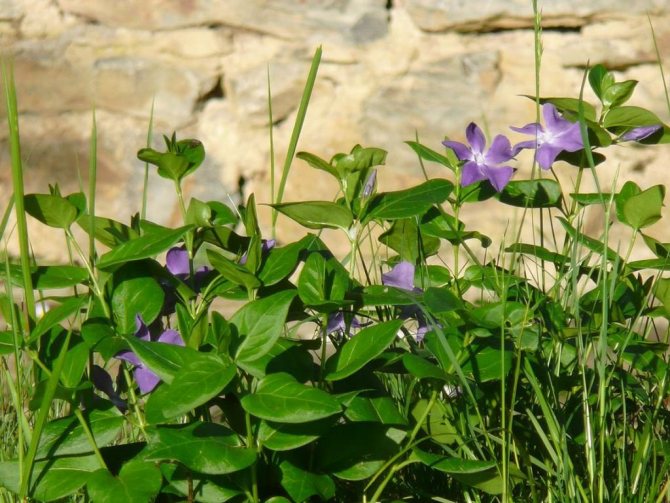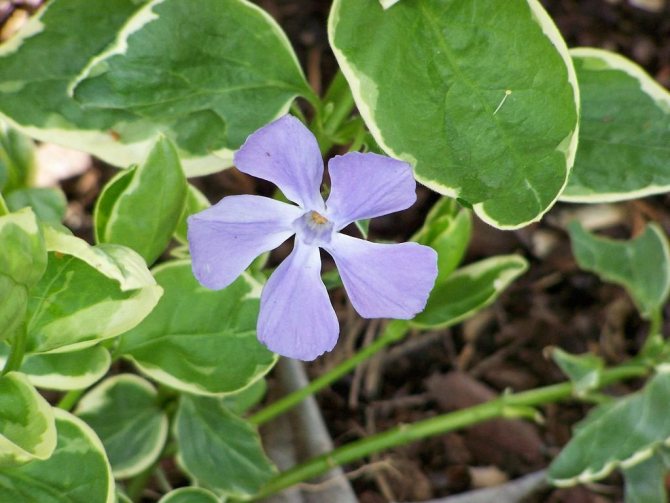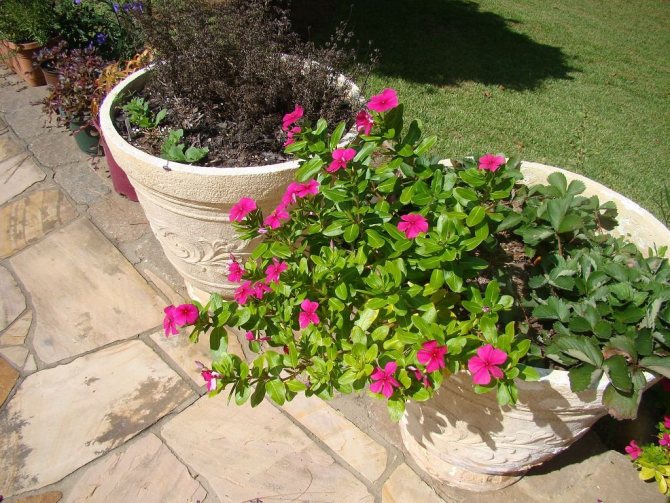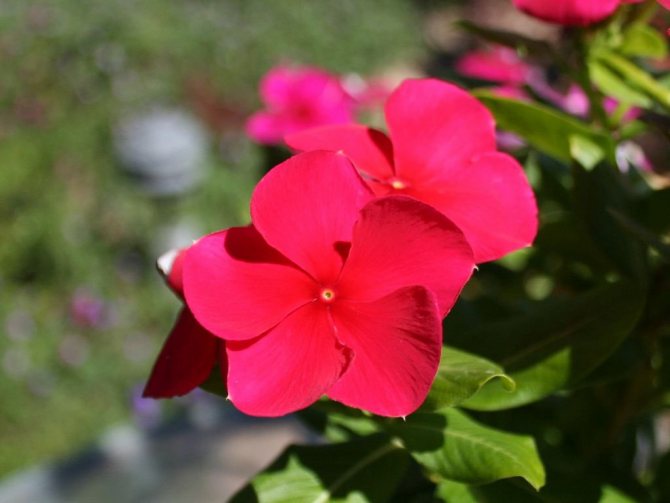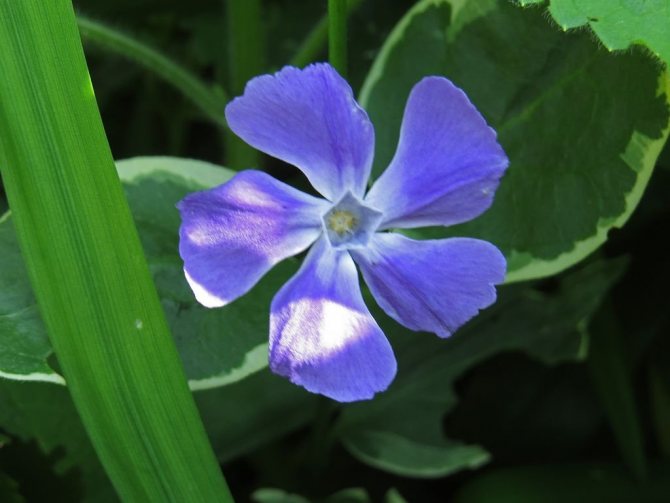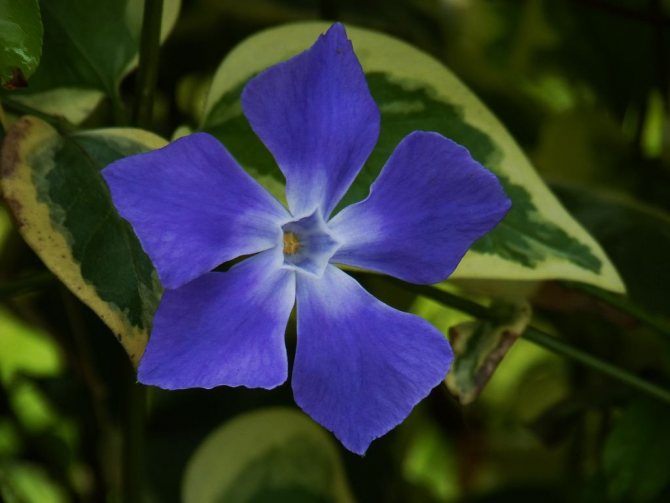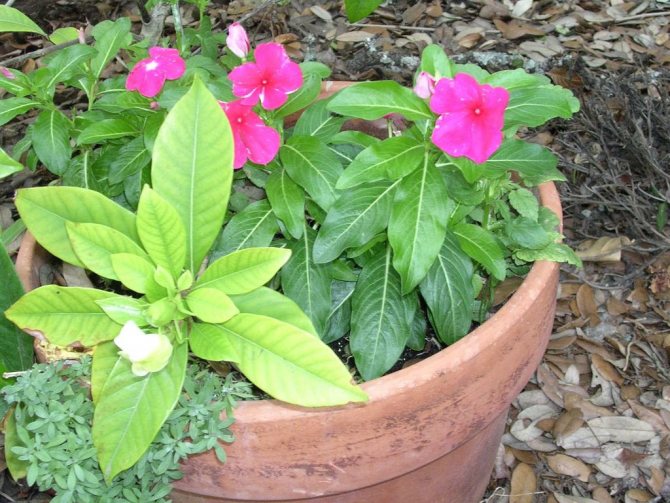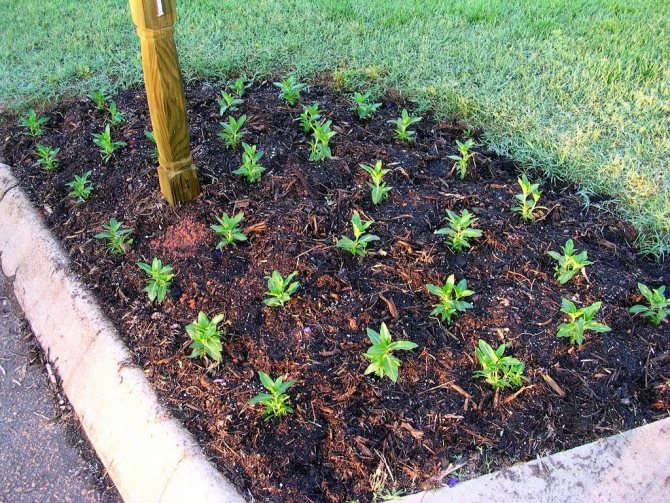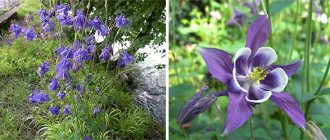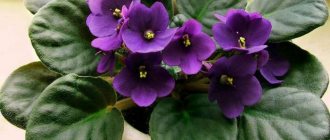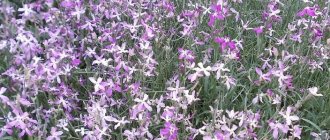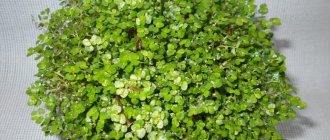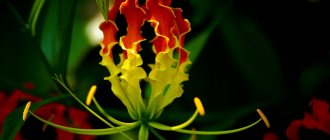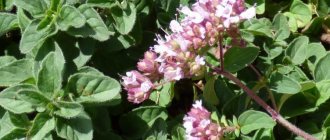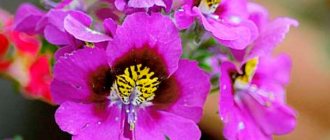Periwinkle is a creeping plant, so it is often used to complement flower arrangements or garden decoration. The culture is considered especially valuable during the flowering period, when the shoots are covered with small but numerous inflorescences. At the same time, the periwinkle successfully performs its decorative function the rest of the time, covering the ground with a lush carpet of leaves.
Many people know this culture as a plant with blue flowers, but there are about 12 species of periwinkle with certain characteristics of cultivation and care. This article will describe the main ones, as well as recommendations for planting and caring for the crop.
- When to sow
- How to care for the garden
- How and when to collect seeds
Planting a plant
Periwinkle takes root on any soil, it can be planted on the slopes of the site. The perennial will grow rapidly and cover the unsightly terrain with a bright green carpet with blue blotches of flowers. The shrub will grow well in the shade of fruit trees and in the bright sun.
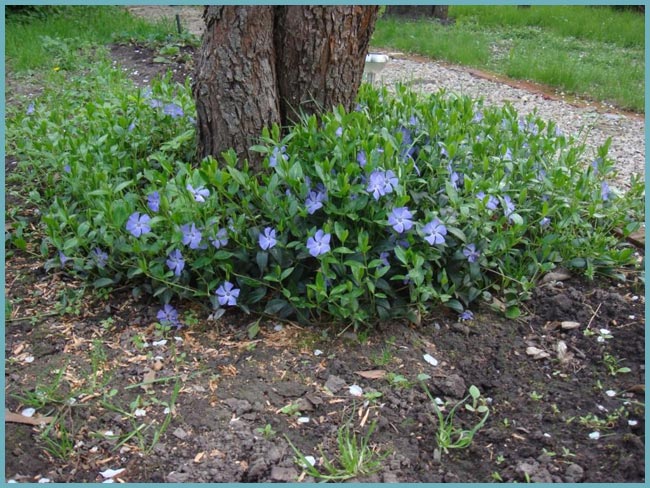
Periwinkle planted in the garden in the shade of trees will look very good
You should adhere to this planting scheme for periwinkle: given that it is a perennial, besides actively growing, it is recommended to plant plants at a distance of at least 30-35 cm from each other.
Botanical characteristics
Periwinkle is a perennial with branched shoots lying or creeping on the ground. It forms a sprawling bush up to 35 cm high or a solid green carpet. The roots are located horizontally, close to the surface of the earth. They grow in length up to 70 cm.
On thin stems covered with light green or reddish bark, opposite petiole leaves of an oval or ovoid shape grow. Their dark green leathery surface shines in the sun, and a lighter vein is visible in the center. The length of the leaves is 3-5 cm, and the width is about 2.5 cm. Some species retain foliage throughout the year or shed it during an unfavorable period.
Flowering occurs in May-June. Large single flowers bloom in the axils of the leaves. Corolla with a long tube and five bent petals separated along the edge is about 3 cm in diameter. Stamens and ovary column only slightly protrude from the center. The petals are colored blue, purple or pink. Sometimes the saturation of the hue at the base and edge of the petals is different.
After pollination, the fruits ripen - crescent green leaves about 7-8 cm long. Inside them are elongated light brown seeds with a rough surface.
Caring for periwinkle
Caring for periwinkle in the open field is extremely simple - it can be planted on any soil, both in shaded and sunny places. It is necessary to ensure watering only in the early stages of plant growth; in the future, it perfectly manages the moisture contained in the soil, it is drought-resistant. Even in the hottest summer, it is recommended to water the periwinkle no more than once every 7-10 days.
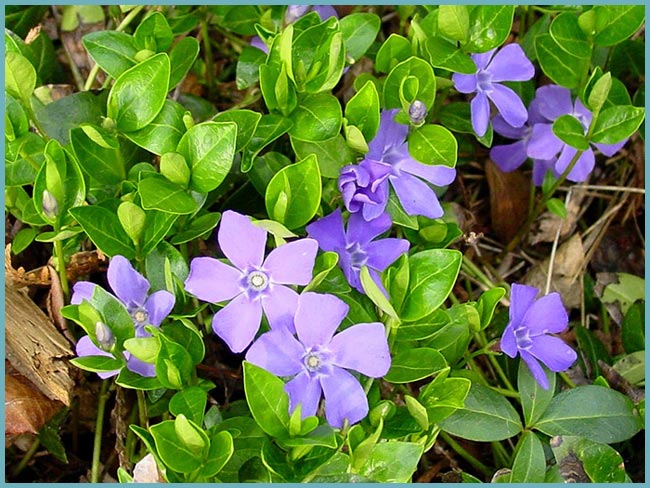

Periwinkle needs almost no care
Despite the fact that this perennial is quite frost-resistant, landscape design experts recommend covering young shoots with foliage for the winter.
Outdoor care
The periwinkle is planted in open, sunny places or under the thin shade of deciduous trees. Plants prefer well-drained, loose soils with a neutral or slightly acidic reaction. Sand or crushed stone is introduced into heavy clay soil before planting. Planting is best planned on a cool, cloudy day. In the future, caring for the plant is very simple.
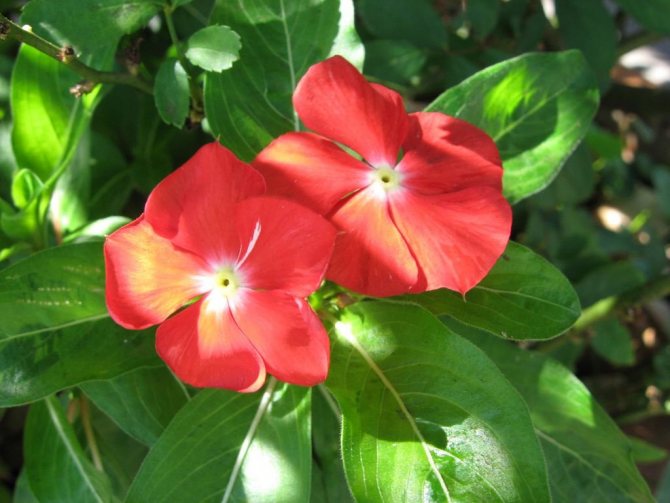

Watering. Periwinkle is able to withstand a slight drought. In the absence of natural precipitation, one watering per week is enough for him. A little more moisture is needed during the flowering period, then the green carpet will be abundantly covered with sky-blue flowers. Several times a month, the soil near the plantings is loosened. An overgrown bush is able to independently cope with weeds. Care must be taken, as in a flower garden, periwinkle can behave aggressively, displacing neighbors. For a year without pruning, it can fill up to 7 m² of the territory.
Fertilizer. Twice or three times a season, periwinkles are fed. On fertile soils, the need for feeding is much less. Preference should be given to organic compounds, but universal mineral complexes can be used. They are applied to the soil in early April, May and July.
Pruning. When the first wave of flowering is completed, pruning is recommended. With it, wilted flowers and part of too long shoots will be removed. But soon new shoots will appear.


Diseases and pests. In too thick plantings, periwinkle can suffer from fungal diseases (leaf rust, powdery mildew). Regular cutting and soil treatment with fungicides helps. In hot weather, aphids can settle on the leaves, which will help to quickly get rid of "Karbofos", "Biotlin" or other specific insecticide.
Reproduction of periwinkle
Periwinkle, like other perennials, can be propagated in several ways:
- seeds;
- dividing the bush;
- cuttings;
- taps.
The most simple is the planting of periwinkle using dividing the bush... The separated piece of plant quickly takes root in a new place and grows. Experts recommend planting periwinkle in spring or early autumn. It is possible in the summer, but in this case it is necessary to moisten the soil under the plant and at the new planting site.
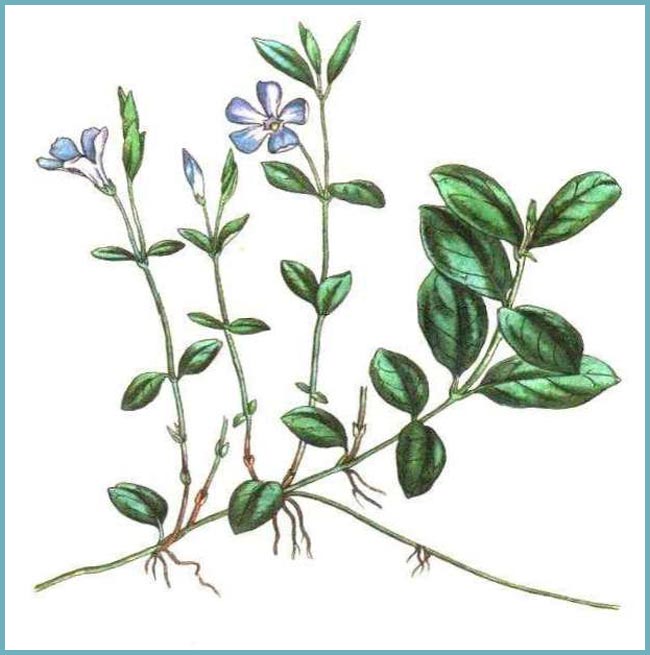

Pattern: periwinkle bush
Periwinkle reproduces well and cuttings... It is necessary to cut the young shoots and bury them using the seating scheme as with propagation by bushes, leaving only a couple of leaves on the surface. In the future, the culture will grow and cover the entire area allotted to it with a green carpet.
For getting diversion you should dig in the shoot of the plant, and after rooting, separate it from the mother bush and transplant it to a permanent place of growth.
Seeds perennials are sown in the spring in boxes to a depth of no more than 2 cm. They are covered for a week with a dense cloth or a dark film that does not allow light to pass through. Seedlings should be grown from seeds indoors or in heated greenhouses, since the comfortable temperature for their germination is above +23 degrees. After the emergence of seedlings, boxes with seedlings are exposed to the light, while the temperature can be below +20 degrees. Seedlings dive after the appearance of the first 4 true leaves at a plant height of about 9 cm.
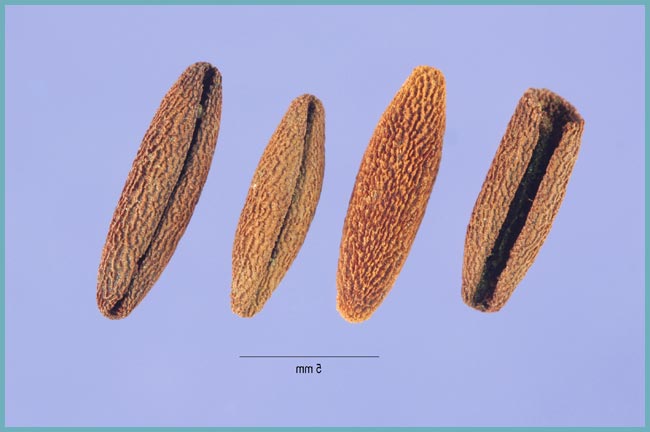

Periwinkle seeds
Experienced gardeners recommend breeding periwinkle in spring, then before winter the plant has more chances to take root, get stronger and survive the winter safely.
Types and varieties
Traditionally, it is believed that the flowers of the culture should be blue or blue, but in fact there are many more varieties of the culture, and the inflorescences can be not only blue, but even cream or pink.
To make it easier for you to choose the right variety for your site, we will consider the most popular species in more detail, and the photos will help to objectively assess the external features of each of them (Figure 2).
Pink
This species has a high decorative value, as it belongs to evergreen shrubs, the height of which can exceed half a meter. In addition, the pink variety, unlike its congeners, has a late onset of flowering, which lasts from late spring to autumn.
Pink periwinkle became the basis for the creation of new hybrids, the flowers of which can be pink-purple or even red, and flexible shoots are used to decorate the walls of buildings or planters.
Periwinkle Kiffa
The Kiffa variety was bred by breeders specifically for growing in pots at home, although if desired, containers with a plant can also be exposed to the open air.


Figure 2. The main varieties of culture: 1 - pink, 2 - Kiffa, 3 - Pacific
A distinctive feature of the variety is the relatively compact size of an adult plant, as well as a large flower size unusual for this species. In most cases, the inflorescences are evenly colored hot pink, but pink and burgundy specimens can also be found.
Periwinkle Pacific
This variety belongs to bush, and the inflorescences in shape and size resemble phlox flowers. In young plants, shoots are erect and covered with large leathery oblong leaves. As they grow older, the shoots stretch out and become more flexible. This allows the variety to be planted in hanging planters or pots.
Most representatives of the Pacific variety have white inflorescences, but sometimes there are also pale pink buds. This is due to the fact that the plant is a hybrid and was artificially bred.
Diseases and pests
Periwinkle is a perennial resistant to many diseases. However, it can be affected by aphids, scabbard, fungal diseases (for example, powdery mildew). To destroy aphids and scale insects, it is recommended to irrigate the plants with soapy water. For the prevention of powdery mildew, proper watering of the shrub should be ensured - it does not tolerate waterlogging, does not grow on swampy soils.
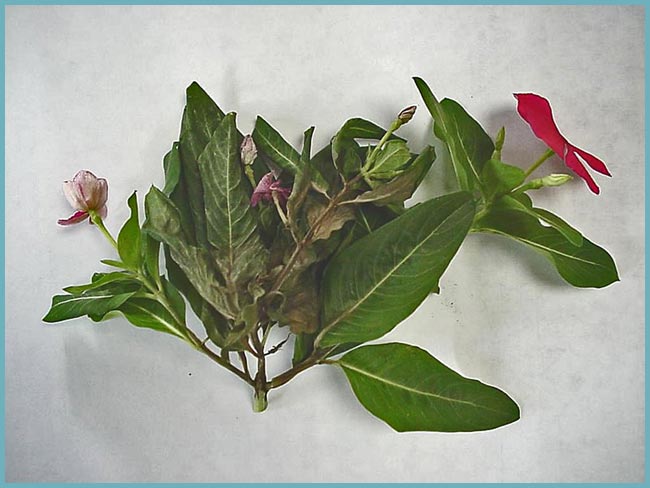

A periwinkle bush affected by a fungal disease
Medical use
The alkaloid contained in the plant is used in pharmacology in the manufacture of anticancer drugs. Also known as a component of immunosuppressants. Due to the presence of glycosides, periwinkle is used in the fight against cardiovascular diseases.


Periwinkle pubescent helps to lower blood pressure, herbaceous is useful for hypertension, small periwinkle has a positive effect on the work of the heart. The flower contains tannins, acids, as well as vitamins and sugar.
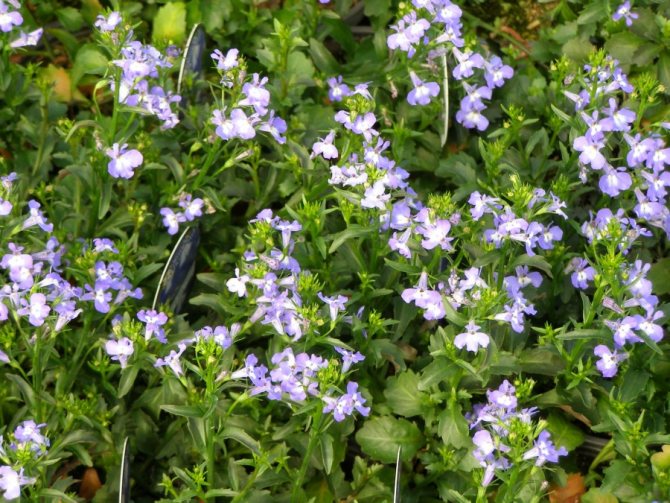

It is used to treat osteochondrosis, ischemic disorders, atherosclerosis, nervous disorders, depressive conditions, and ENT diseases. Some species have antimicrobial and wound-healing effects.
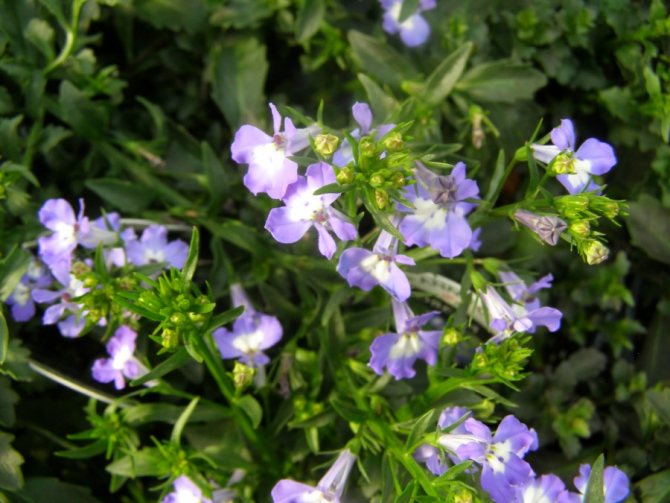

Periwinkle has not only decorative and aesthetic, but also medicinal value. It does not require much care, it multiplies and grows easily. This plant is perfect for gardens and backyards.
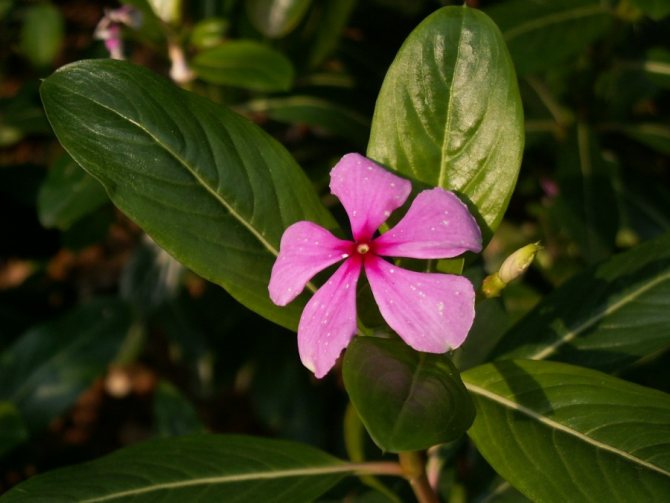

Periwinkle in combination with other plants
Growing up, the periwinkle completely covers the territory allotted to it with a green carpet. This perennial is ideal in garden landscaping, it grows well between trees and shrubs. Grows well in combination with:
- lungwort;
- spills;
- primrose;
- hyacinths, other bulbous plants;
- forget-me-nots.
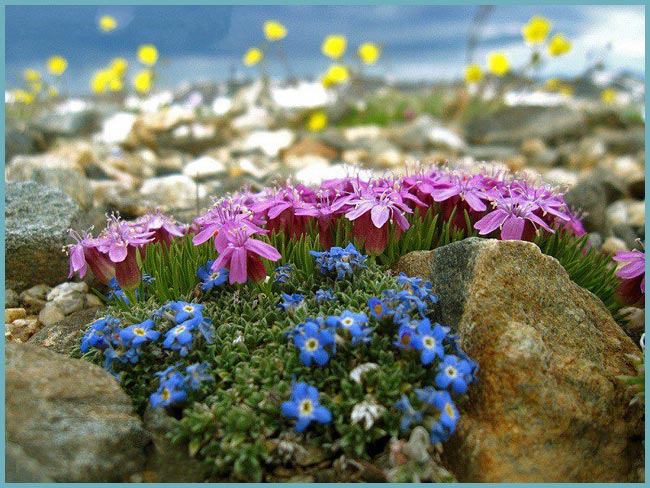

Periwinkle combined with cloves
The decoration of the site will be the planting of a variety of ferns on a periwinkle pillow.
Tip: control the growth of periwinkle, otherwise it can turn into a weed and drown out crops.
Varieties
Representatives of the genus Periwinkle in their natural environment are found in Eurasia and North Africa; perennial grasses and creeping dwarf shrubs are hidden under the name. On the basis of four wild ancestors, decorative varieties were bred, which were loved by amateur gardeners.
Garden favorites include the great periwinkle (Vinca major), with its largest leaves and flowers among relatives. It blooms for about a month in May; possibly a second, shorter flowering in September. Ornamental varieties include Reticulata and Variegata; their leaves are adorned with beautiful yellowish-white streaks.
Small periwinkle (Vinka minor) is a plant with creeping stems reaching a meter in length, with small dense green leaves and blue flowers. This evergreen dwarf shrub is moderately frost-resistant and is subdivided into several varieties:
- Atropurpurea. A plant with purple-purple flowers. This periwinkle forms a dense cover in the landscape, grows well in shade and partial shade.
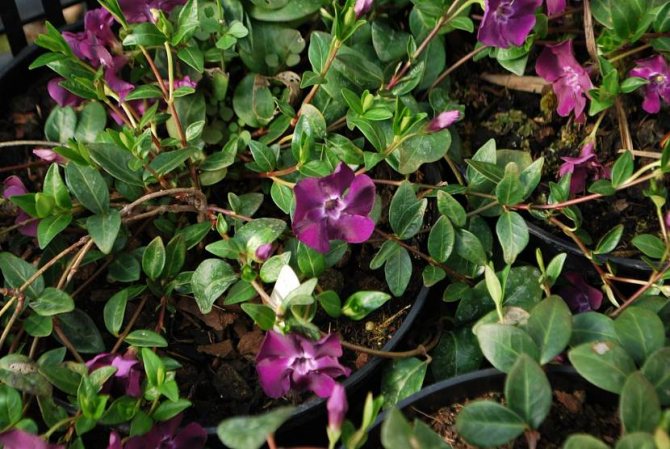

Atropurpurea Source emeraldplants.co.uk
- Alba. A plant with single white flowers up to 2.5 cm in diameter. The branchy stem reaches a length of 60 cm, the leaves are dark green, shiny on the front side. Alba can grow in sunny areas, but prefers shade and partial shade, where it blooms longer (25-30 days, in May-June).


Alba Source i.
- Bowles Cunningham. It is characterized by sky blue flowers and many neat, shiny leaves. It can be planted in shaded areas, and it prefers moist and nutritious soil.


Bowles Cunningham Source img04.
- Variegata periwinkle variegated. An evergreen perennial with light blue flowers and an elegant white edging of the edge of the leaves.
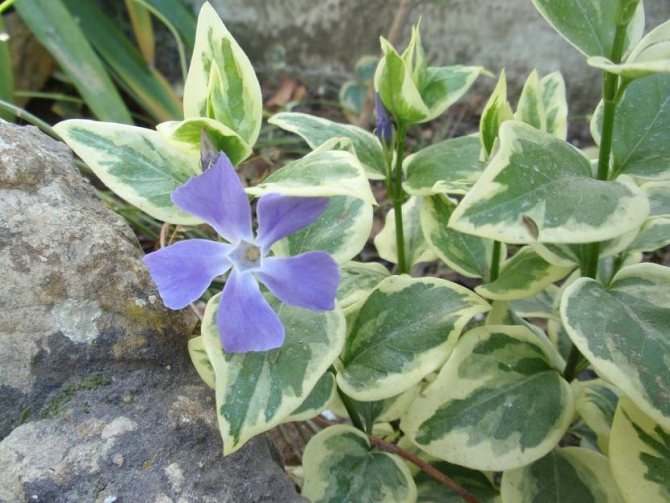

Variegata variegated Source lh5.
- Gertrude Jekyll. A variety with white flowers and a stem up to 60 cm long. It tolerates frost well, but needs protection in a snowless winter (it is enough to cover it with spruce branches).
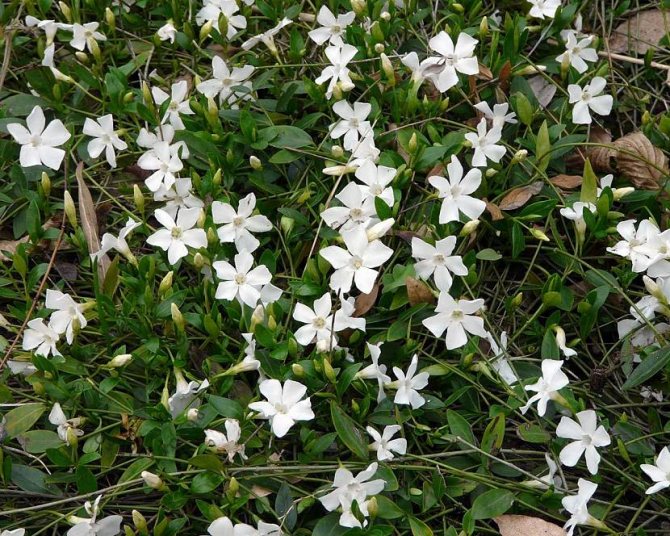

Variety Gertrude Jekyll Source s.
The herbaceous periwinkle is interesting for its blue, purple or blue-violet flowers. This variety was brought from the Middle East region and its popular varieties include First Kiss, Cascade and Grape Cooler. The herbaceous periwinkle is suitable for growing in the Moscow region and regions similar in climate. It suffers from frost more than others, therefore it requires a particularly careful winter shelter.
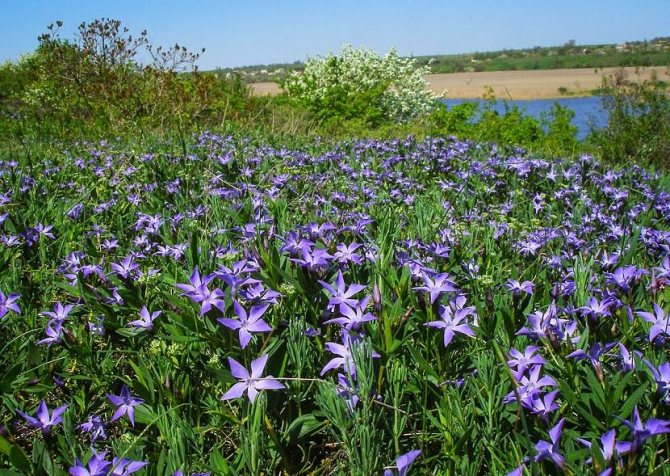

The pubescent periwinkle grows naturally in Primorye. The bush does not form such a dense covering as other varieties, sheds leaves for the winter, but tolerates frosts well enough. The flowers are small, dark blue.
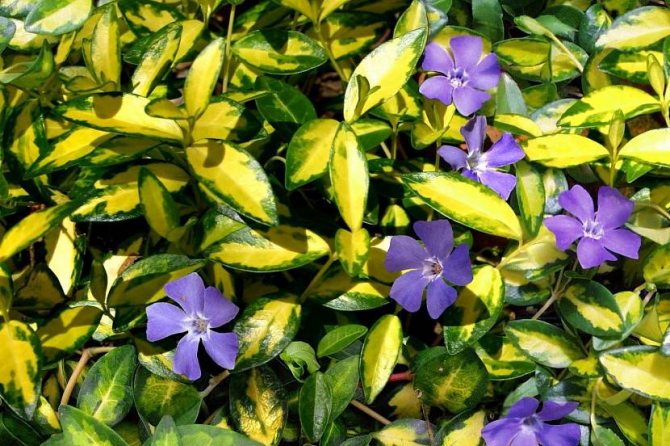

Blue and Gold Variety Source
On our website you can find contacts of construction companies that offer services for the design and implementation of landscape works of any complexity. You can communicate directly with representatives by visiting the Low-Rise Country exhibition of houses.
Periwinkle in landscape design
Periwinkle is often used in open field design to decorate wide borders, bordering ridges, this plant looks great in mixborders. In any photo, periwinkle sets off and emphasizes the beauty of the cultures that grow with it.
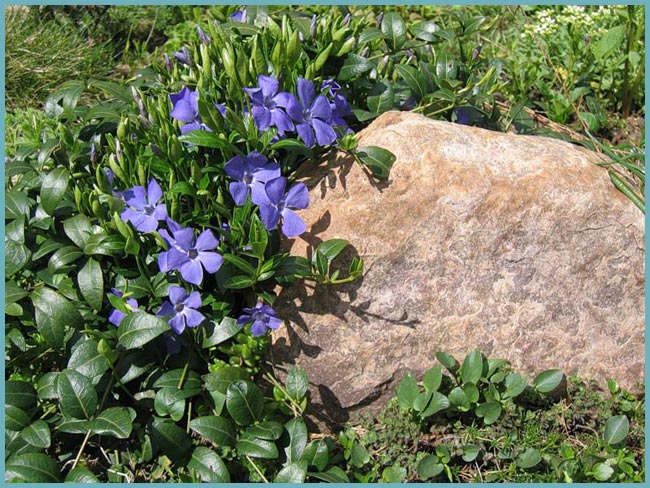

Periwinkle in landscape design
Plant a periwinkle on the site and get an excellent opportunity to enjoy the view of a living green carpet all year round.
Decoration
Periwinkle can be a wonderful garden carpet decoration. It is combined with lungwort, primrose, forest trees, as well as hyacinths and forget-me-nots. The plant is also used in the design of flower beds, borders, rabatok. It is perfect for decorating and strengthening slopes and hills at the same time.
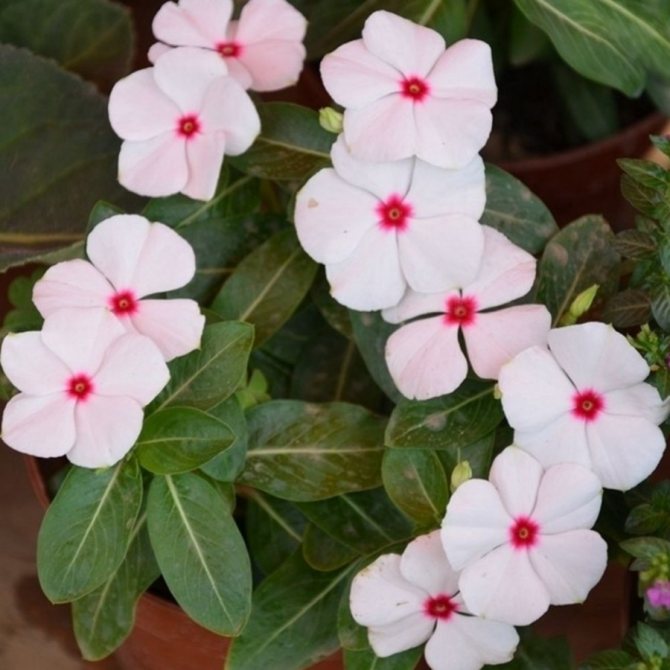

Often used as an ampelous plant - the periwinkle hanging from the walls of the retaining walls looks great against the background of the stone.Thanks to its bright colors, the perennial serves to place accents on the flower bed.
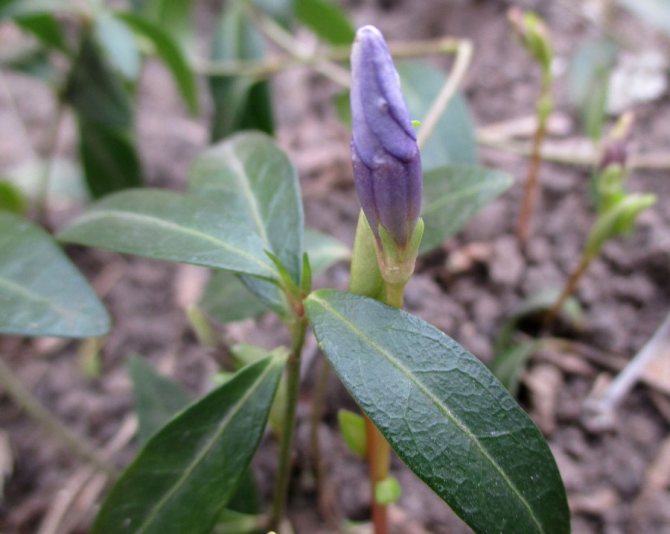

Periwinkle: photo
Breeding methods
Periwinkle reproduces by seeds, cuttings and layering. For amateur gardeners, experts recommend using one of the vegetative methods for growing a flower. Growing a flower from a seed is harder and much longer.
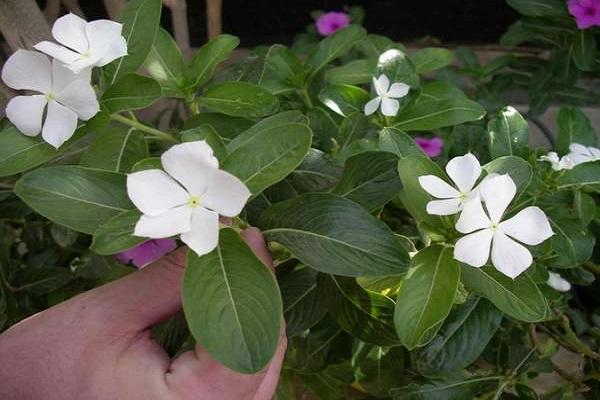

A stalk is cut from the middle of healthy, mature shoots. The interval between planting material is 20-30 centimeters. Landing on the site is carried out in the spring or at the end of summer.
Evergreen species are propagated by dividing the bush. To do this, the shoot in one place is firmly pressed to the ground and fixed with a metal hairpin or applied with pebbles. The next year, when normal roots are formed, the branch is cut off. If you use this method, the probability that reproduction will be successful will be almost one hundred percent.
Medicinal properties
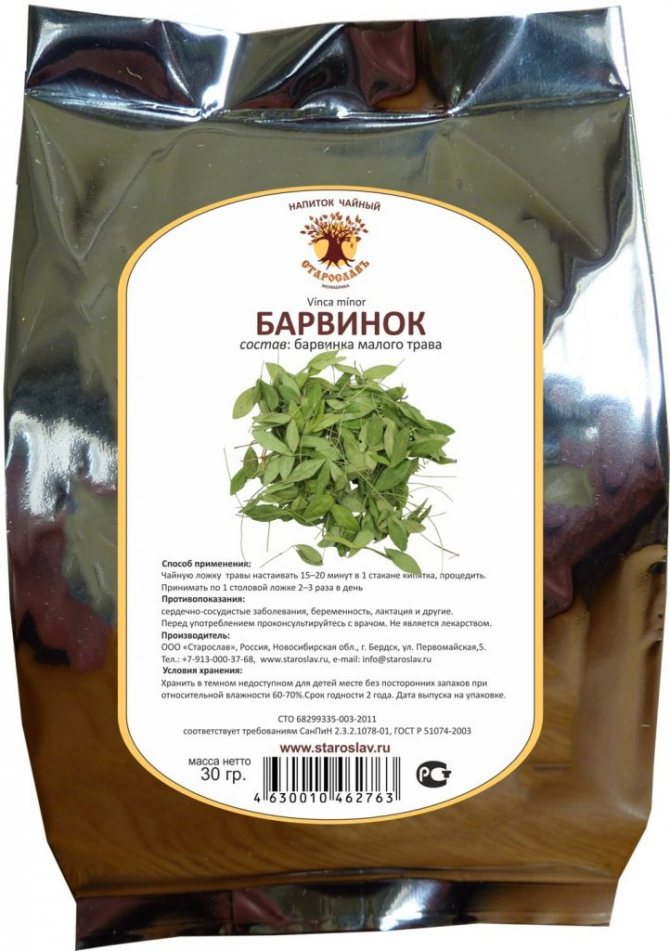

Periwinkle is actively used by traditional medicine
It helps to cure many diseases:
- Hypertension
- Dysentery
- Tuberculosis
- Impotence
- Toothache
- Migraine
- Eczema
- Skin diseases
- It stops bleeding
- Treats cancer
For the manufacture of medicines, it is used by pharmacology. On its basis, the anticancer drug Rosevin is produced, which blocks the growth of cancer cells.
Periwinkle contains many alkaloids. One of them, vincamine... It improves blood circulation in the brain, improves memory, relieves headaches. Homeopathic medicines are made on its basis.
Another alkaloid - devinkan, helps with mental disorders and neuralgia.
Periwinkle helps with skin burns, it relieves burning and heals wounds.
back to menu ↑
See also: Beauty and Scent: Growing Lavender from Seeds at Home. Description, varieties, planting and care, stratification (50+ Photos & Videos) + Reviews
Periwinkle harm
Periwinkle is a poisonous plant, so its use is permissible only under the supervision of an experienced herbalist.
Infusions and decoctions are contraindicated:
- Pregnant women
- Nursing mothers
- Children under 14 years old
- With bradycardia, constipation
- People with increased blood clotting
back to menu ↑
See also: Medicinal plants and herbs: if you think you know everything about them, then you are very mistaken + Reviews
You need to plant rowan near the porch
I am not a supporter of planting any tree close to home, because I do not like to do unnecessary work - sweeping fallen leaves from the floor of the veranda in autumn or faded flower petals in spring. But some acquaintances claim that it is urgent to plant rowan trees at the very entrance to ward off evil spirits.
The answer to this superstition is simple. It turns out that since pagan times, the Slavs, Scandinavians and Celts believed that this tree protects from witchcraft and wars, and crosses from its twigs will help from the evil eye. The underside of the rowan berry is like a star, one of the ancient pagan symbols of protection.
Photo Nadia
Why does not it bloom
The most likely reason why there is no flowering is excessive darkening. If you plant periwinkle under trees, then as much light passes through the crown as the plant needs. But in dark spruce forests, flowers do not appear on the plant.
Rotting roots due to the fact that the soil is not loose, not saturated with air, but also highly filled with moisture, which stagnates, leads to death. Such conditions contribute to susceptibility to various types of diseases, which negatively affects the entire plant, especially the ability to bloom flowers.
Also find out why jasmine does not bloom and grows poorly.
To attract good spirits, you can plant a birch on the site
With this belief, everything is clear - the birch has always been considered the most "Russian" tree, light and dear. Even today, many, walking in the forest, hug a birch and talk to it in a moment of sadness. But in the country, planting birch is possible only with a large area of the site.The roots of a birch spread in breadth, and it is impossible to grow other crops near it, not only because of the shade, but also because the birch draws all moisture from the ground. MNBer
writes: “Around the birch we mentally outline a circle according to the projection of its crown. We plant nothing in this circle, it will not grow, only grass (well, there are also lilies of the valley, but they will creep from the trunk anyway, the neighbors have a periwinkle sitting stunted). You can arrange pots, stumps, carts, all kinds of beauty, birch has a diffused shadow, everything will grow in pots. And behind the projection of the crown, you can start planting either annuals or flowers with a powerful root system. "
It is necessary to bury aspen stakes in the corners of the site
This superstition came not only from the biblical traditions that aspen is the cursed tree on which Judas hanged himself. Even in pagan times, aspen twigs were stuck into a wattle fence or into the walls of buildings where cattle were kept. Aspen leaves have very thin petioles, so they tremble from the slightest wind, as if they were "afraid" of something. In addition, the aspen grows very quickly, the trunk does not have time to build up its power, and in a strong wind this tree sways and rapidly loses its leaves. Our ancestors believed that an evil force would also be afraid of aspen branches and would not penetrate the territory. Now witches and other evil spirits have clearly been excluded from the evil force, but they have not ceased to be afraid of thieves and the evil eye, therefore, in the corners of the site and at each pillar of the gate and wicket, some stick aspen stakes.
Photo Mishal
You can't cut your own fruit trees in the country.
It is believed that to cut down an old fruit tree, you need to hire someone, and not uproot it yourself. This prejudice also has its roots in pagan traditions. It so happened historically that the life of the Slavs was associated with trees, therefore, many beliefs about trees are firmly rooted in our minds. It was believed that the fruit tree is a kind of "double" of man. At the birth of children, it was customary to plant his "own" apple, pear, or other fruit tree.
Photo of pear BabaTanya
Apple tree photo bagira123
Description
Periwinkle is a perennial plant. The ground cover culture is beautifully lined with a bright carpet in the flower beds. If you plant a periwinkle in a flower garden, then this will solve the problem with weeds. The plant grows rapidly, covering the ground. Therefore, the weeds have no chance.
Opposite leaves have a smooth, shiny surface. Even under a layer of snow, the leaves remain fresh and green, since periwinkle is an evergreen crop.
Single flowers are funnel-shaped. Colors: blue, blue, lilac. To date, breeders have bred many varieties with a variety of flower colors.
How to keep periwinkle in winter
The species large and pink need special covering. The rest tolerate cold and frost well. Young plants can be protected so that the shoots do not freeze. In order to support the perennial in winter, the bushes of the first year are covered with straw, spruce branches or fallen leaves.
It is important not to remove shelters too early because spring weather is very changeable. It is recommended to mulch young seedlings with rotten organic matter before the onset of winter.
Did you know? If the lovers break the leaf in half and eat each of their share, their connection will not end - the halves of the leaf connect the hearts.
Flower magic
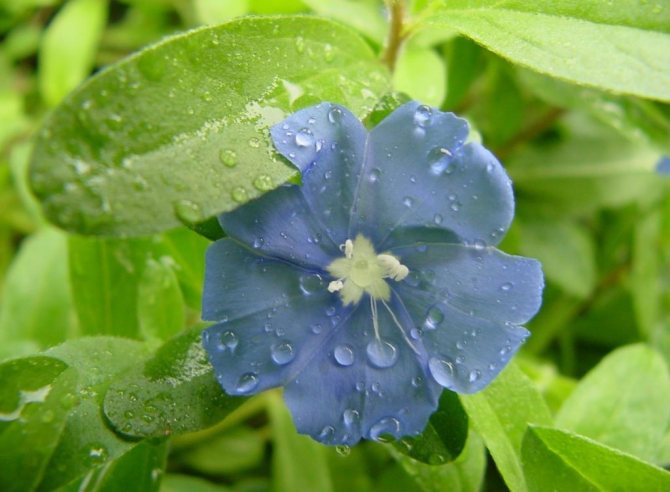

Periwinkle people attribute magical qualities
This is due to his enormous vital energy. If the flower is cut and placed in a vase, it will live as long as there is water in the vase.
For Ukrainians, he is a symbol of true love. There are many legends and traditions about the origin of periwinkle:
- During the invasion of the Tatars, the village was somehow destroyed. The boy and the girl hid in the thicket of the forest.Enemies found them and killed them, a periwinkle grew out of the blood.
- The man loved the girl very much. After death, he began to ask God to release him to earth. The Almighty returned him in the guise of a flower. And the plant trailed where the foot of his beloved walked. When she died, he grew up on her grave. Therefore, it is also called a burial ground or coffin-grass.
Periwinkle is a symbol of the memory of the departed... It is often planted in cemeteries.
It is believed that by planting periwinkle, people lure happiness and love into their home. Unmarried girls put 2 flowers of wine under the pillow at night, this ceremony was considered to attract grooms. If an annoying boyfriend annoyed him, then in order to discourage him, they put leaves of a plant in men's shoes and put their noses to the road.
During the Inquisition, witches were checked by periwinkle. Before execution, plant leaves were thrown into a hot frying pan. If the sheet bounced, it means that the victim is definitely connected with evil spirits. Imminent death awaited her.
back to menu ↑
See also: Daisies: description, perennial and biennial varieties, growing from seeds, reproduction and care (50 Photos & Videos) + Reviews
Growing seedlings
The longest way to grow periwinkle is by seed. Such a plant will bloom only in the third year. Sowing seeds directly into the ground is more often used. But you can also use the seedling method. Seeds for seedlings are planted in March or early April.
Soil and capacity
For sowing, shallow containers, peat pots or tablets are suitable. The substrate should consist of the same amount of peat and sand. You can add vermiculite for looseness. Embed the seeds 1.5 cm deep into the substrate. Keep a distance of 3-4 cm between them.
If you use peat tablets, they must be filled with water to make them swell. Then stick 2-3 seeds into each. Put containers with seeds for germination in a room at about +23 degrees, cover with foil.
Seedling care
When sprouts appear, the shelter can be removed from them. After rooting, transfer the container with seedlings to a bright place, reduce the temperature to + 20 ° C. Diving into individual pots is carried out when the seedlings reach 8-9 cm in height. It is recommended to regularly but moderately water the plants. You can fertilize seedlings 3 weeks after they emerge.
Transplanting
You can plant seedlings outside in May, when the weather is warm. This usually occurs in May. Dig holes so that the root system of the seedlings fits in them. Pour water over them, you can add a little rotted humus. Together with the earthy clod, lower the seedlings into the hole, sprinkle with earth, tamp it. The distance between the holes should be 20-25 cm. The plant grows quickly and covers the soil.
Requirements for soils, planting site
These beautiful plants have moderate planting requirements and maintenance procedures.
- Soils. Periwinkle grows best in humus and fertile lands, but copes well with the worst conditions. The semi-shrub has no requirements for soil acidity - it can grow on slightly alkaline and slightly acidic soils. The substrate must be kept slightly moist, although the plant tolerates temporary droughts well.
- Shade tolerance. An important advantage of periwinkle is that it grows well in places that many plants do not like, namely in partial shade. It can grow in dense shade, but will not bloom in such a place. Periwinkle tolerates bright sun, but then the bushes need to be watered regularly.
- Top dressing. You do not need to intensively fertilize the plant - it is enough to feed it every 3-4 years. In spring or autumn, you can use compost or mineral complex fertilizer (with nitrogen), and in autumn - fertilizer containing potassium and phosphorus, which makes it easier for the shrub to endure frosts in winter.
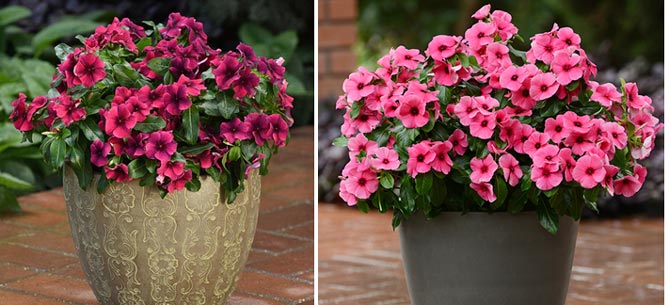

Sun tolerance varies from cultivar to cultivar. Shady and fully shaded positions tolerate varieties well:
- Atropurpurea (Atropurpurea);
- Gertrude Jekyll.
Reveals fully the qualities only on sunny and slightly shaded positions of the variety:
- Ralph Shugert;
- Periwinkle large variegated - should always remain in a light or lightly shaded place.
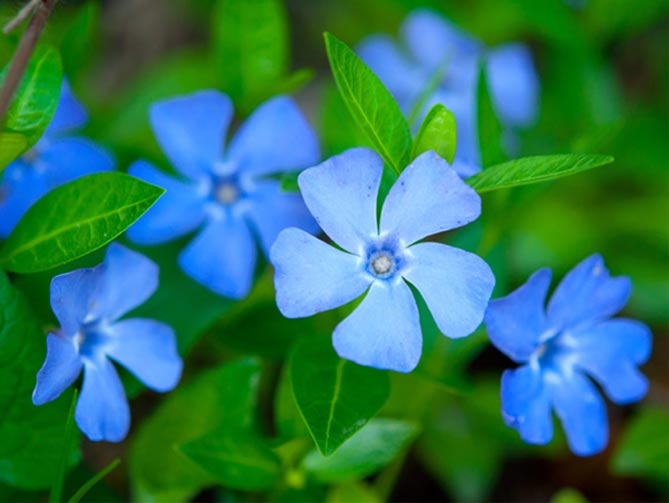

Care errors
| Problem | Cause | Remedies |
| Leaves turn yellow, dry, fall off. | Too dry air in the room, irregular watering, direct sunlight, violation of the temperature regime. | Increase the humidity and frequency of watering, prevent the substrate from drying out, remove shriveled parts of the shrub, lower the temperature to normal (+ 18… + 25 ° C). |
| Few or no buds. | Drafts, unsuitable fertilizers, cold air and sudden temperature changes. | Change the location of the pot, excluding blowing and do not use nitrogenous fertilizers during the period of active flowering and bud formation. |
| The flowers bloom and fall. | Poor lighting, infrequent watering. | Move the periwinkle, providing access to the sun's rays, water more often. |
| The edges of the foliage plate dry, turn yellow. | Low humidity. | Spray the shrub more regularly. |
You can not plant spruce on the site
We do not have a winter pass to the country house, but we really want to celebrate the New Year in our house and decorate our own Christmas tree in the yard!
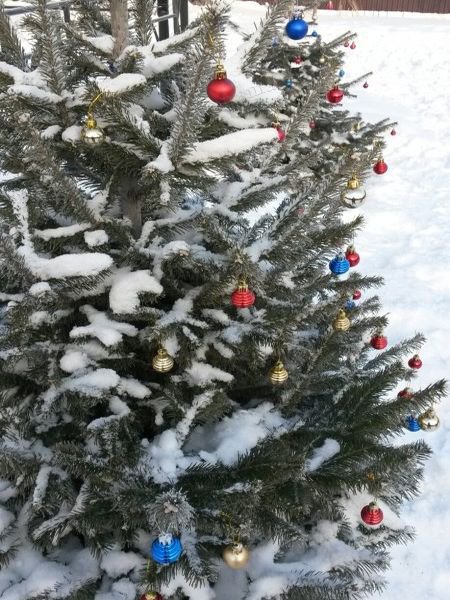

Photo *** sale ***
But there is also a bad omen for eating. It is believed that a spruce is bad: loneliness, death, and as soon as it grows higher than the house, then the one who planted it dies. Of course, these are all superstitions. They are connected with the fact that in the old days the heating in the houses was stove, the houses themselves were one-story, and the spruce, growing up, could partially close the chimney with its powerful branches. In our time, such signs are already useless. The only thing bad about the spruce is that it is really high, and you need to choose for it so that it does not shade the garden area and neighboring plots. In addition, spruce needles acidify the soil, so the spruce should be planted away from flower beds and beds.
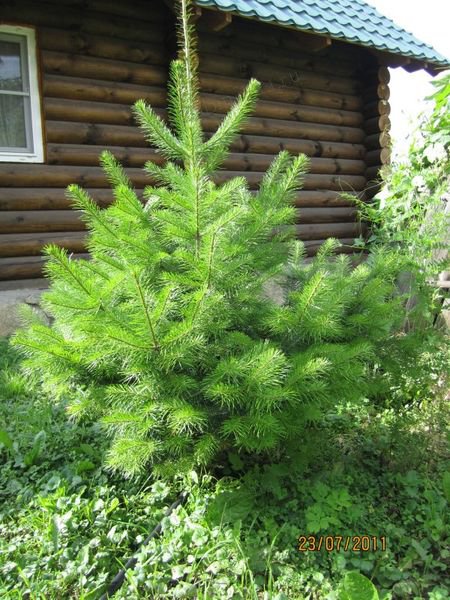

Photo Black Nigella

